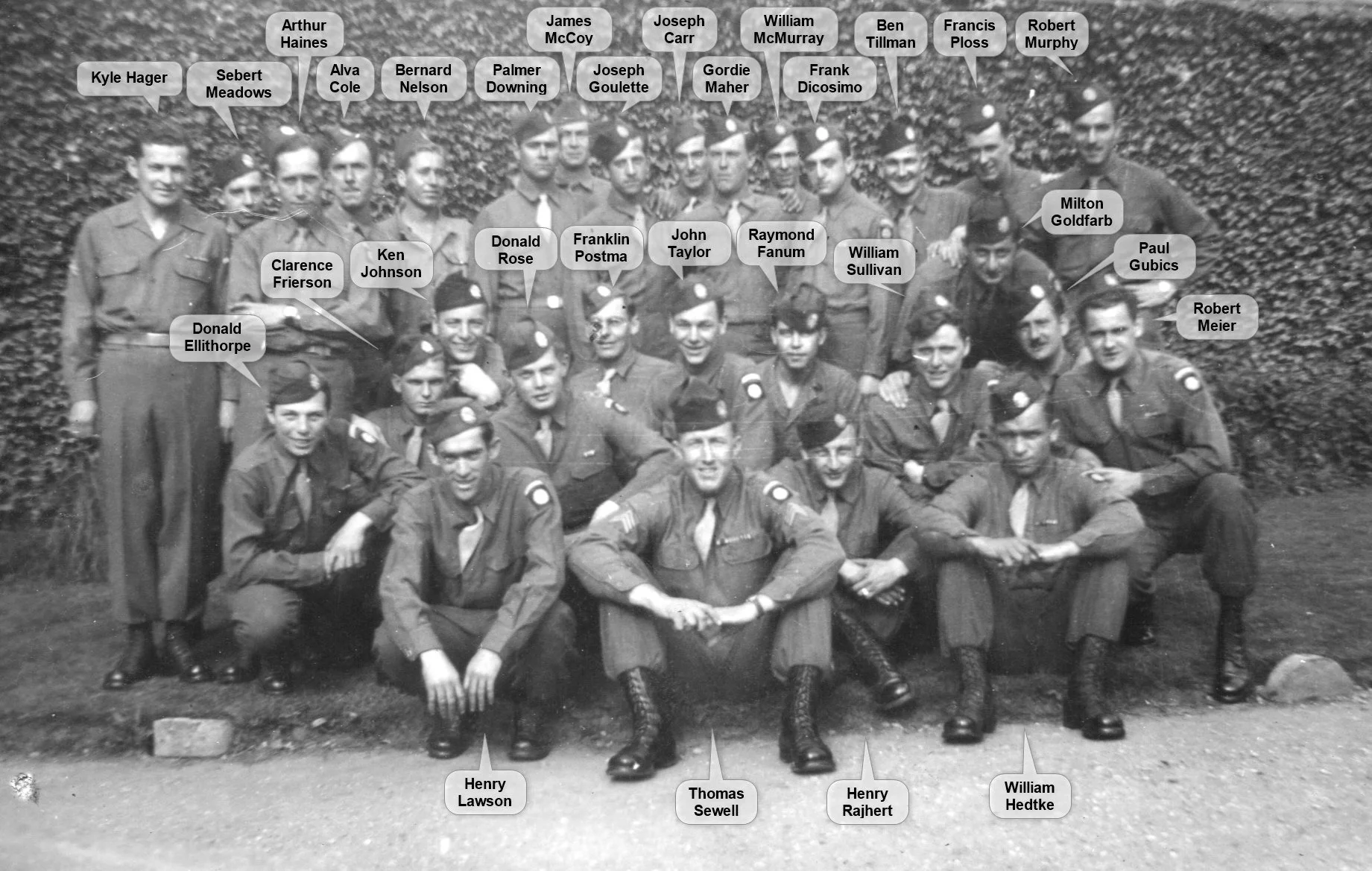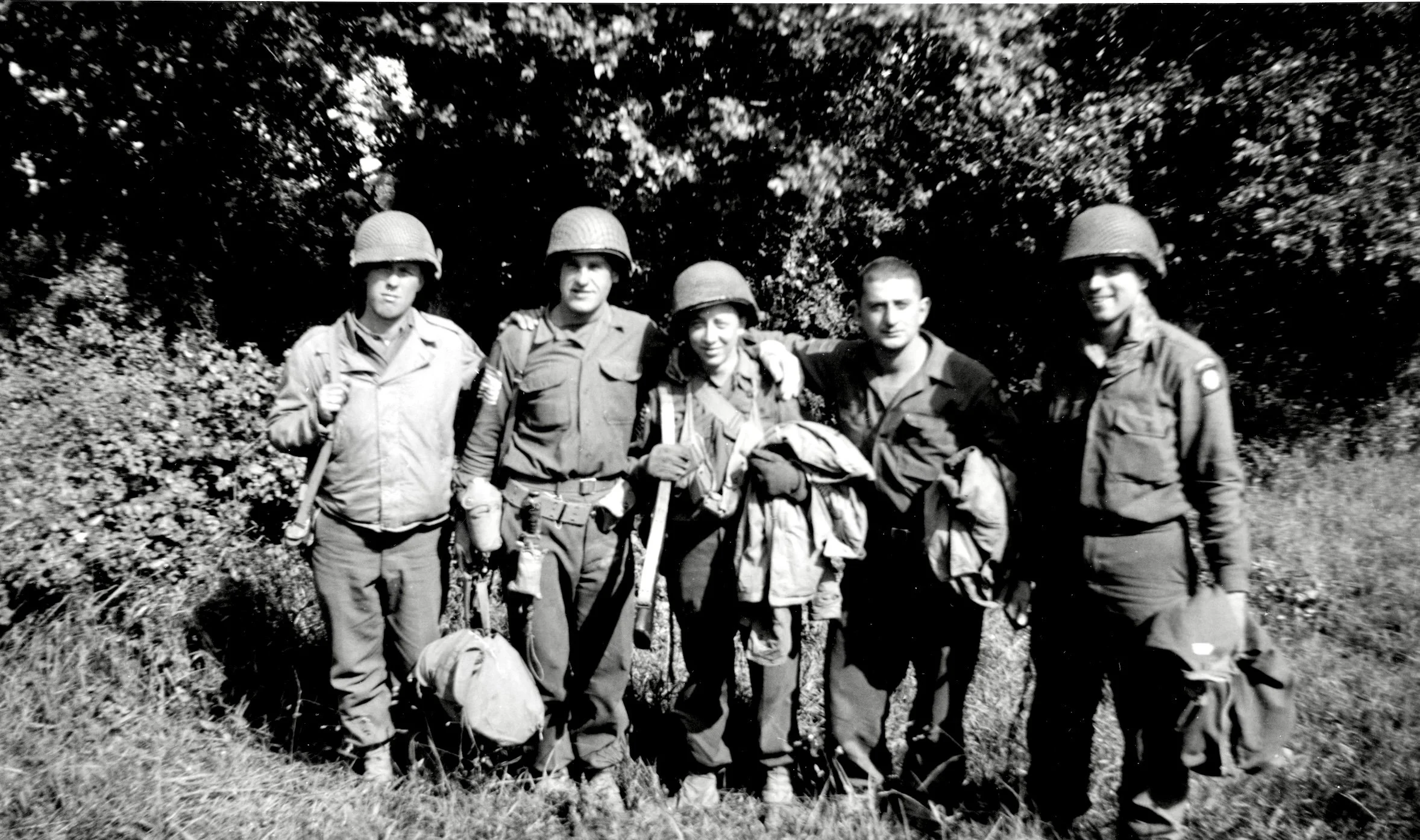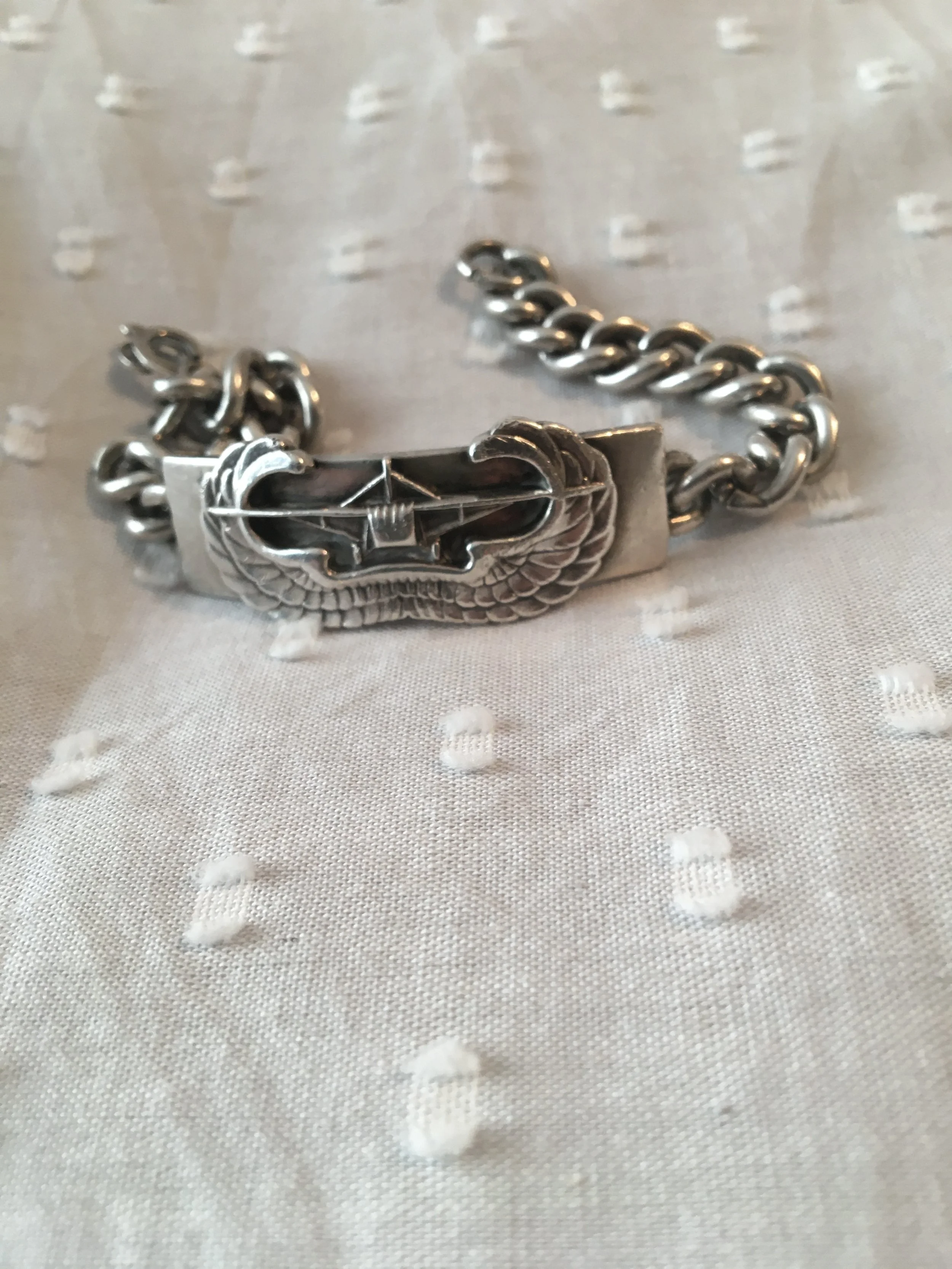Milton Goldfarb
ASN:32519223
PFC Milton Goldfarb
Milton Herbert Goldfarb registered for the draft on June 30, 1942. Born July 13, 1922 in Brooklyn, New York, he was employed at Gal-Zor Manufacturing in Brooklyn at the time of his registration.
This nineteen-year-old enlisted in the US Army on October 3, 1942 at Fort Jay Governors Island, New York. He was 5’-9”, 190 pounds with a light complexion, blue eyes, and black hair. No identifying physical characteristics were listed at the time of his registration.
As a member of the 82nd Airborne Division, now an airborne battalion, he trained as a radio operator with B-Battery, 319th Glider Field Artillery at Fort Bragg, North Carolina.
The 82nd Airborne was later deployed to the Mediterranean Theater of Operations. PVT Goldfarb sailed with the battalion from Staten Island, New York, aboard the SS Santa Rosa to North Africa arriving in Casablanca May 10, 1943.
Company Morning Reports
Company Morning Reports were produced every morning by the individual Army units to record personnel matters. The following events for Milton Goldfarb were reported:
August 28, 1943, erroneously omitted from remark of July 21, 1943, Pvt. Goldfarb from arrest in quarters to duty. Station: 11 miles north of Bizerte, Tunisia, North Africa.
March 3, 1944, from duty to furlough 5 days to Doncaster, England. Station: Papillon Hall 4 miles west of Market Harborough.
March 8, 1944, from 5 days furlough to duty at 1930. Station: Papillon Hall 4 miles west of Market Harborough.
July 17, 1944, from duty to furlough 5 days, Birmingham, England, 0600. Station: Papillon Hall 4 miles west of Market Harborough.
July 22, 1944, from furlough 5 days Birmingham, England to duty, 2300. Station: Papillon Hall 4 miles west of Market Harborough.
October 17, 1944, from duty to absent sick hospital at 0830 the 7th, from absent sick to duty at 1600 the 11th. Station: Papillon Hall 4 miles west of Market Harborough.
October 17, 1944, from duty to absent sick the 10th Oct ‘44 non-battle casualty duty 531 to duty the 12th Oct 1944. Station: Papillon Hall 4 miles west of Market Harborough.
October 22, 1944, from duty to absent sick at 95th hospital at 0900. Station: Papillon Hall 4 miles west of Market Harborough.
January 8, 1945, from duty to absent sick hospital the 3rd Jan 1945 (non-battle casualty) duty MOS 238. (Lineman/Repairs Telephone and Telegraph) Station: Camp Suippes, VT6863, Nor D’Guerre.
January 8, 1945, appointed to Private First Class, effective January 1, 1945. Station: Camp Suippes, VT6863, Nor D’Guerre.
January 14, 1945, from absent sick to duty. Station: Camp Suippes, VT6863, Nor D’Guerre.
February 3, 1945, from duty to absent sick hospital non-battle casualty the 1st Feb, 1945. Station: Stavelot, Belgium VK7201, Nor D’Guerre.
February 5, 1945, from absent sick hospital non-battle casualty to duty. Station: Stavelot, Belgium VK7201, Nor D’Guerre.
February 11, 1945, CORRECTION M/R of 3 Feb 1945. PFC Milton H. Goldfarb, from duty to slightly wounded in action, Belgium to the hospital, 1st Feb 1945. Station: Stavelot, Belgium VK7201, Nor D’Guerre.
February 26, 1945, from duty to absent sick non-battle casualty. Station: Stavelot, Belgium VK7201, Nor D’Guerre.
March 1, 1945, from absent sick hospital non-battle casualty to duty. Station: Camp Suippes, France VT6863, Nor D’Guerre.
March 6, 1945, from absent sick hospital non-battle casualty to duty. Station: Camp Suippes, France VT6863, Nor D’Guerre.
June 23, 1945, transferred to Battery B 681st FA BN. Station: Lubtheen, Germany RT Nord DeGuerre.
Milton Goldfarb fought in the major campaigns of Sicily, Naples-Foggia, Normandy, Holland, Ardennes and Central Europe.
While stationed in the Filipo Pollizzo of Naples, Italy (October 1943) following the 319th’s first combat mission, Milton Goldfarb (Below - standing 2nd soldier from the left) posed for the camera with fellow B-Battery soldiers.
Prior to the Normandy campaign the 319th was stationed in Northern Ireland and Market Harborough, England. They also conducted artillery training near Sennybridge, Wales.
(See Below - B-Battery Ammo Section - Sennybridge, Wales
August 1944 - Milton Goldfarb standing far right)
Steve Zwerko (L-R) John Pachmayer, Milton Goldfarb - Papillon Hall - 1944
In early April of 1944, the 319th Battalion left Ireland and traveled to Papillon Hall in the town of Market Harborough, England. Market Harborough was a British Royal Air Force station, a place for allied military training, and also where the glider men went for training and replacement soldiers.
Papillon Hall itself was a large structure, first built in 1903, that was requisitioned by the army during World War II. It was used as a billet for the 319th Glider Field Artillery and other units of the 82nd Airborne. The building itself was set-out in a butterfly pattern with four distinct wings.
The soldiers (see photos below) lived in the main building and a cluster of quonset huts. But no space was wasted, there were eight men to a room. The men also slept in horse stables and barns.
Group B-Battery photo (also below) - Station Papillon Hall, Market Harborough, England - 1944
Milton Goldfarb top row right leaning forward
Above photos courtesy of the John Pachmayer Family
During the Normandy campaign Milton Goldfarb glided into France the evening of June 6, 1944, with B-Battery of the 319th Glider Field Artillery. The battalion landed in the German front lines which resulted in 2 officers and 15 enlisted men killed, 6 officers and 86 enlisted men wounded upon landing.
Just north of the town of Sainte Mere Eglise Milton Goldfarb and others freed themselves from the crashed Horsa gliders and were immediately under enemy small arms fire. As the men ran to the surrounding hedgerows for cover Goldfarb barely noticed the piece of wood piercing his eardrum. He then came upon fellow soldier Steve Zwerko, a native of Chicago, Illinois. Zwerko was a good friend and had been seriously wounded in the leg by machine gun fire.
Goldfarb later recalled, “Zwerko’s leg was hanging by a thread, I cut it away with my knife and made a tourniquet with his boot laces. I dragged him to the cover of a tree and gave him my “booze” flask and a pack of Camel cigarettes, knowing I had to find a medic.” Goldfarb grabbed Zwerko’s carbine rifle, a veteran of combat in Italy, he knew Zwerko had a better chance of surviving if the enemy found him unarmed. Despite a horrific injury and losing his leg below the knee, Steve Zwerko survived the war.
PFC Milton Goldfarb (second from right) - Normandy D+
Courtesy of the 82nd Airborne Division War Memorial Museum
During the first week of February 1945, the 319th was in combat near Hurtgen, Germany. PFC Goldfarb was wounded in action while supporting the 508th Parachute Infantry in its mission to seize and hold the high ground overlooking the Roer River.
On May 8, 1945, the war in Europe was officially over. Germany unconditionally surrendered its armed forces.
The Adjusted Service Rating Score (ASR) was a system the U.S. Army used at the end of the war to determine when soldiers were eligible for discharge. PFC Milton Goldfarb (98 points) was one of many “High Point” soldiers with a score over 85 points. Those soldiers were the first to be sent home and discharged.
Prior to returning to the USA on September 14, 1945, PFC Goldfarb was stationed at Camp Chicago, Marchais, France and in mid-June 1945 the battalion moved to Epinal, France.
PFC Milton Goldfarb (standing)
In the absence of strenuous military training, athletics became the only structured activity to occupy the men’s attention during daylight hours. The Army encouraged sports activities as a way to keep the men fit and work off some energy through a safe outlet. As a result, football, basketball, and baseball teams were all organized at both the battalion and division level.
Milton Goldfarb was an athlete and an aspiring major league baseball player. He played on the B-Battery baseball team as a catcher. One game or another was held nearly every day and members of winning teams were rewarded with week long furloughs to Nice or Paris, France.
Goldfarb and others distinguished themselves as talented ball players. Rivalry between the teams of various outfits was intense.
PFC Milton Goldfarb catching behind home plate
The battalion also organized a basketball team to compete against other US Army units while stationed in Northern Ireland. Players were recruited from the four batteries. The 319th team (see photo below) played competitively at RAMP Camp Epinal.
PFC Milton Goldfarb standing far right
Milton Goldfarb separated from the service on September 21, 1945, at Fort Dix, New Jersey, and returned to his hometown of Brooklyn, New York.
Below are several photos courtesy of the Goldfarb family greeting and assuredly overwhelmed with the safe return of their son.
Purple Heart - Good Conduct
His service was awarded with the Good Conduct Medal, Distinguished Merit Badge Oak Leaf Cluster, European/African Middle Eastern Service Medal Ribbon with 1 Silver Battle Star, 1 Bronze Battle Star, 4 overseas Service Bars, 2 Service Stripes, one bronze service arrowhead, Glider Badge, Belgian Fourragere, Purple Heart and World War II Victory Medal.
Above images courtesy of the Goldfarb Family
STL Archive Records
Milton Goldfarb, 76, died September 4, 1998. God Bless this hero.























